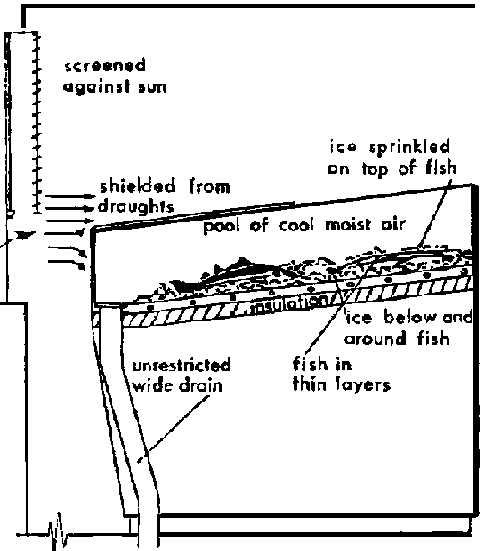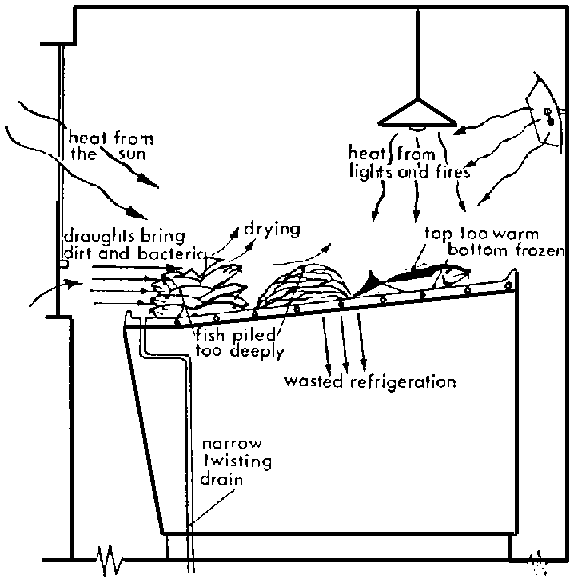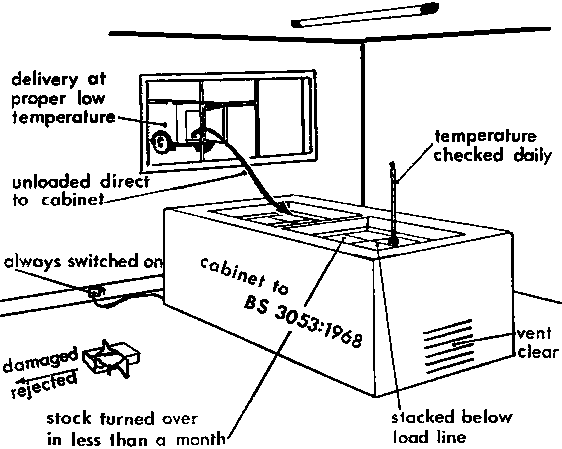Introduction
Chilled fish display
Smoked fish
Frozen fish products
This note gives advice to the retailer on the proper use of display units for fresh and frozen fish. Chilled wet fish, smoked fish and frozen fish products each require different forms of protection if quality is to be maintained, and this leaflet summarises some of the precautions that must be taken to ensure that the customer receives his purchases in the best possible condition.
Chilled fresh fish, which contains no frozen water, requires storage at or near 0°C, the melting point of ice; frozen fish has already been reduced to a temperature of - 30°C during manufacture, and requires retail storage at - 18°C or lower.
Some mention is made of the use of bulk storage containers in retail shops, where this can affect the quality of the product on display, but the advice is concerned mainly with the use of slabs and cabinets used to display the goods to the customer.
Wet fish on display must be kept cool, clean and moist.
The fish should be kept as near as possible to melting ice temperature; it should already be at this temperature before it is laid out since cooling in the display cabinet is from one side only, and therefore very slow. If the fish has been delivered from the wholesaler intimately mixed with, and surrounded by, ice, then it should be at the right temperature; if, however, there is little or no ice left amongst the fish when it is received, then it should be re-iced and stored long enough to bring it back down to ice temperature. But better still, insist on delivery of well iced fish.
If the fish is processed in any way before sale, for example if it is filleted or steaked, then again make sure that the fish warms up as little as possible during these operations, and that it is down to temperature before it is laid out. Remember that cold tap water is often very much warmer than ice temperature.
Ice is essential for keeping the displayed fish cool; refrigerated slabs, properly used, can help to prevent excessive melting of the ice, but cannot replace the use of ice altogether. Accurate temperature control is difficult with a refrigerated slab and no ice; cooling takes place only at the bottom of the fish, and harmful partial freezing may occur in some parts of the fish, while exposed top surfaces remain too warm.
A bed of ice should be laid beneath the fish and a further sprinkling of pieces on and around the fish will keep it cool more efficiently and enhance its appearance.
Insulation beneath the slab will help to make sure that the cooling capacity of the ice expended on the fish and not on the air and structure beneath. In addition a cooling coil can be incorporated in the slab between the insulation and the ice to prevent the ice melting too quickly; the temperature must not be so low however that the ice cannot melt at all.
Fig. 1. Fresh fish, ideally displayed on ice.

Fig. 2. The dangers of misusing an unprotected refrigerated slab.

Since a thermostat can be in only one place and usually has a temperature differential of 1 to 2 degrees, control of slab temperature may be difficult. Ice, however, is its own thermostat.
A transparent upstand, of glass or perspex, at least 150 mm high around the edge of the slab will help to keep a pool of cool moist air around and above the fish, and will restrict draughts of air which can dry out the fish.
Lay out the fish in thin layers - fish is a poor conductor of heat and deep piles of fish will not be effectively cooled.
Serve customers from the display, rather than leave the display intact by serving from bulk stock; this ensures that the displayed fish is being renewed continuously and always looks its best.
Make sure that the slab has adequate drainage; this means a wide unrestricted pipe so that unsightly melt water drains away quickly, taking with it blood, slime and scales that could accumulate on the slab.
If refrigerated slabs are used without ice, here are some of the things that may happen to spoil the product:
(a) if the slab is refrigerated by a coil built into the slab, the fish will be cooled from one side only; this will be a slow process, because fish is such a poor conductor of heat. If the amount of refrigeration is increased to overcome this, the fish may be reduced to a temperature below freezing point; the fish may then freeze to the slab, and partially frozen fish lose flavour and become tough and chewy. In addition, the cold slab will encourage deposition of moisture on slab and fish; this moisture must in the absence of ice come from the air in the shop, and can bring with it dust and bacteria.Ice, then, is the only reliable way of keeping wet fish cool and moist while on display. If ice is not readily available locally, it may be worth considering the purchase of a small ice-making machine for the shop, as an alternative.(b) if the slab is cooled by circulated air, the drying effect is serious; the moisture leaves the fish as water vapour and ends up on the evaporator as frost. It is then often necessary to mix in some air from the room to increase the humidity, with the result that the refrigeration plant has to be more powerful to remove the extra heat brought in, and the evaporator becomes heavily frosted. As with the cooled slab type, it is often difficult to avoid partial freezing of the fish in some parts of the cabinet.
(c) a third type of refrigerated container for chilled fish which has been tried unsuccessfully in the past incorporates some kind of cold water spray to overcome the drying problem without resorting to ice. The objections to this type are that the quantity of water involved may be quite large - this introduces drainage difficulties, and makes it difficult for the fishmonger to reach in without getting wet. In addition, splash plates quickly become dirty and unsightly.
Avoid the effects of direct radiant heat on your fish; make sure that the display cannot be warmed up by the heat from wall heaters, or from powerful lights close to the fish, and have blinds that can screen the fish from direct strong sunlight. Fluorescent lamps give off less heat than incandescent lamps of the same lighting power.
Use a slab that can be easily cleaned - don't have awkward comers or crevices that are difficult to get at; clean down the unit every day after the stock has been put away.
Lastly, it is worth while repeating that refrigerated display units for chilled fish have no reserve cooling capacity - they are meant to keep a chilled product cool, and cannot cope with large quantities of warm fish. Only ice can rapidly cool fish that is warmer than it should be, and this is better done in boxes or in a bulk store before the fish go on display.
Smoked fish products must not be laid directly on ice; it is therefore advisable to display these separately from the wet fish, and here the refrigerated slab proves most useful. Smoked fish can of course be displayed quite satisfactorily on metal trays laid on a bed of ice.
Since smoked fish freezes at a lower temperature than wet fish, at about -2°C, the temperature range for display can be a little lower than for wet fish, say from -1° to 0°C.
Display only small amounts of each product, since smoked fish can warm up very quickly, and keep the rest of the stock without ice in the bulk chill.
Remember that most smoked fish products have a shelf life not much longer than for wet fish; smoked products that have been kept frozen in the wholesale store may be allowed to thaw out during the delivery journey to you - this is a perfectly satisfactory arrangement, provided that the thawed products arc treated exactly as fresh ones.
There are a large number of designs of retail display cabinet used for the sale of frozen foods, and not all of them are ideally suited for the proper protection of frozen fish. There is a British Standard, No. 3053; 1968, which lays down the requirements for both open and closed refrigerated display cabinets for the retail sale of frozen packaged foods, and it is emphasised here that any cabinet for frozen fish should have been tested to this standard and approved.
In addition, the National Association of Frozen Food Producers have published a code of practice for the retail sale of frozen foods, and many of the recommendations that they make are embodied in the following advice on frozen fish.
Delivery of frozen fish products to your shop should be in insulated vehicles, so that the rise in temperature between wholesale depot and shop is kept as low as possible; the product can advantageously be further protected during transit by the use of mechanical or other cooling systems fitted to the vehicle. The vehicle should have a distant reading thermometer fitted to give some indication of the temperature of the air in the vehicle. Temperature of storage at the wholesale depot should be -30°C for frozen fish, and temperature on delivery should be as little above this as possible, certainly not above - 18°C, the recommended maximum storage temperature in the retail cabinet.
The retail cabinet designed to the British Standard will maintain its load of packaged frozen foods such that no single package is at a temperature higher than - 15°C in rooms where the air is not warmer than 25°C, but is not designed to reduce the temperature of products that are warmer than this; never attempt to freeze products in the cabinet, nor to reduce the temperature of products that are warmer than -15°C. If you are in any doubt about the temperature of frozen fish products delivered from the wholesaler, ask to have the temperature checked, or refuse delivery.
The contents of the cabinet should never be stacked above the load line marked on the cabinet, since the refrigeration system is not designed to protect products stacked higher than this.
Never keep fish products in a retail cabinet for longer than a month; safe long term storage of frozen fish requires a temperature of - 30°C, and products will deteriorate rapidly if kept at - 18°C for several months.
Never leave stocks of frozen fish standing about outside the cabinet after delivery from the wholesaler, or while the cabinet is being cleaned out; get them into the cabinet immediately on receipt, and keep them there the whole time they are in the shop; any fluctuation in temperature has a harmful effect on frozen fish. Transfer stocks to another frozen food cabinet when cleaning is necessary; if you do not have a second cabinet, clean out when stocks have run right down.
Fig. 3. Correct use of a frozen food cabinet.

Fig. 4. How not to use a frozen food cabinet.

Sell the earliest deliveries first - a frequent delivery service from one distributor will help to maintain the 'first in - first out' arrangement.
Remove all broken or damaged packets - they will lose weight, and the contents will become dry and unappetizing.
Check the cabinet temperature daily, preferably in two places. Make the measurements just below the load line, and well away from the cooler.
Have the cabinet serviced regularly by a competent refrigeration engineer; find out whether the manufacturers offer a maintenance contract when a cabinet is purchased.
Defrost the cabinet regularly, if this is not done automatically, at least once a week.
Make sure that the cabinet is never switched off at night, for example by time switches extinguishing the shop lighting.
If the cabinet fails to work properly, and the temperature rises above - 18°C in any part of it below the load line, get technical assistance, and if possible arrange with a wholesaler to store the contents temporarily.
If the contents have been subjected to a rise of temperature above the recommended maximum, never attempt to refreeze them or to offer them for sale.
Never put unfrozen foods or unwrapped products into a frozen food cabinet. Never put anything into the cabinet that is warmer than - 18°C.
Keep the inside of the cabinet clean and free from ice; clean it out once a week.
Remember that a consumer pack removed from a frozen food cabinet can warm up five degrees in ten minutes in a warm room.
Have a look at your cabinet today - a survey made in
many towns in Britain a few years ago showed that roughly 60% of the retail
packs examined were being kept at temperatures above - 15°C, some of them
as high as -10° to - 6°C.